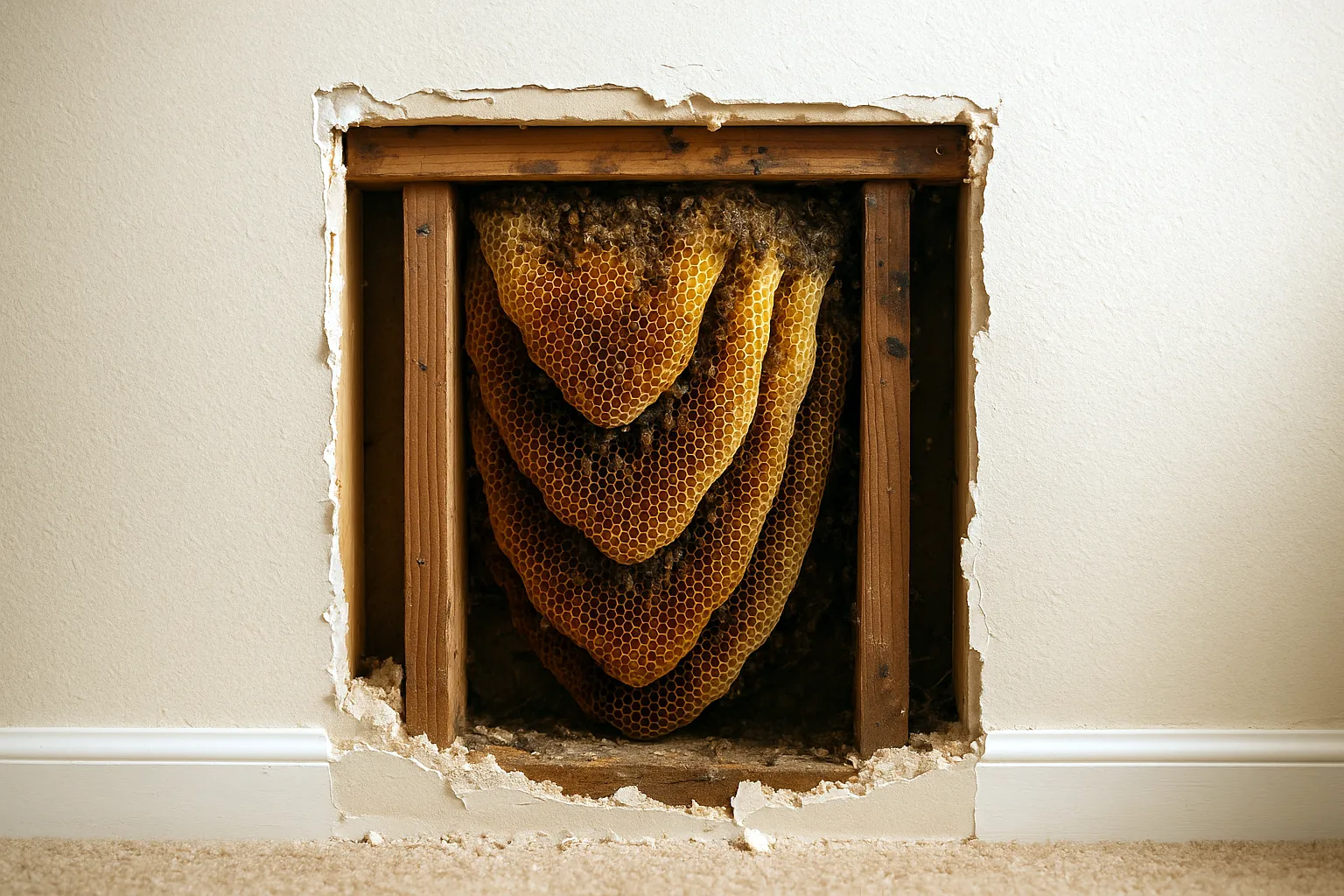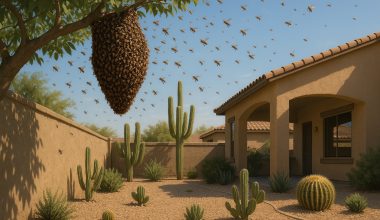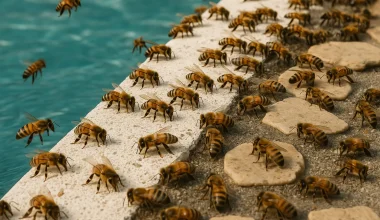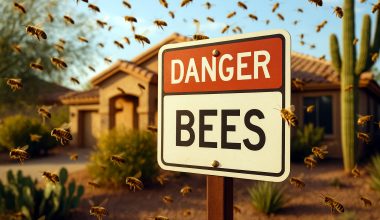Hearing a steady buzz behind the drywall? Noticing sticky stains or a warm patch near an outlet, soffit, or eave? In the Valley, that often means a honey bee colony has moved into the voids of your wall or roof. This guide explains how to confirm what you’re hearing, why walls are so attractive to Phoenix bees, what happens if you wait, and exactly how professional removal works—step by step—so the bees are gone and don’t come back.
Need same-day help? Get a fast, no-pressure estimate here: Request a Quote »
Quick signs you have bees in a wall (or roof)
- Localized buzzing from a specific spot (often louder at dusk).
- Bees flying in and out of a crack at the stucco, roof edge, utility/meter box, or weep screed.
- Brown “coffee” stains or sticky seep through paint/drywall (honey and wax).
- Warm patches on drywall, especially on sunny exterior walls.
- Occasional indoor bees near lights, vents, or electrical outlets.
If you’re seeing a clustered ball of bees outside (on a branch or fence), that’s a swarm—usually temporary. See our homeowner guide: Bee Swarm in Your Yard? What to Do (and Not Do) in Phoenix.
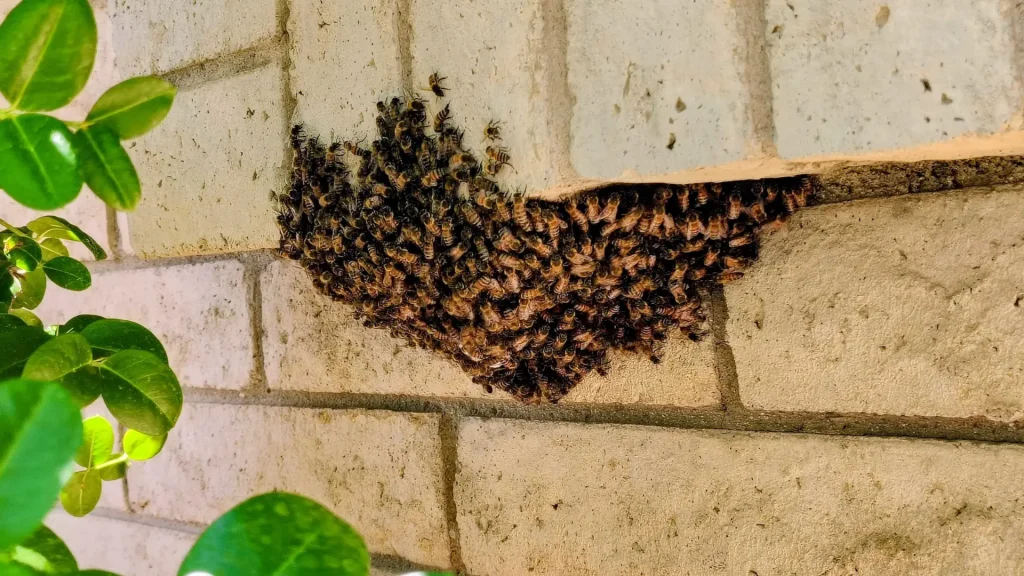
Why walls and eaves in Phoenix are bee magnets
Our climate + construction = perfect hive cavities:
- Stucco over wood frame leaves ideal voids; tiny gaps at light fixtures, soffits, and roof returns are ready-made entrances.
- Tile roofs create shaded pockets bees love.
- Utility chases & meter boxes provide secure, warm cavities.
- Long warm seasons mean colonies can expand fast.
Not sure whether you’re seeing bees or wasps? Here’s a helpful comparison: Bees vs. Wasps in Phoenix, Arizona.
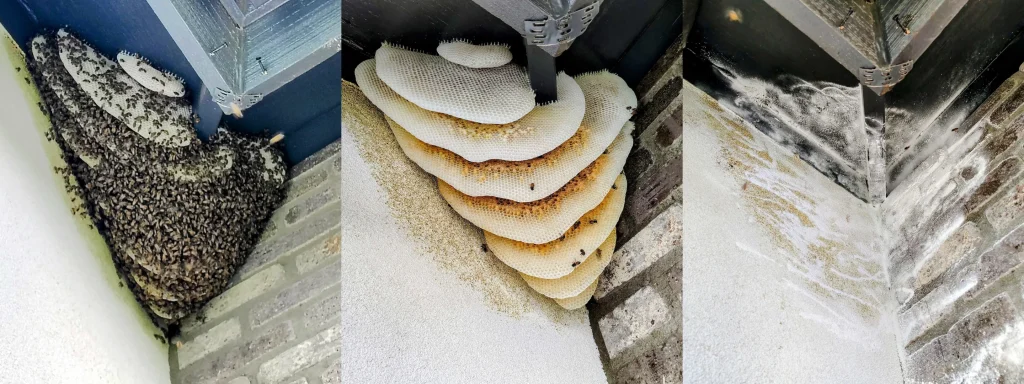
What happens if you wait (it’s not pretty)
Leaving a wall colony to “sort itself out” usually leads to:
- Honey melt & seep: summer heat liquefies honey, which soaks insulation and drywall.
- Odor & secondary pests: ants, roaches, and rodents love abandoned comb.
- Repeat infestations: leftover wax/honey draws new swarms to the exact spot.
- Electrical risks: bees and comb around junction boxes or conduit can create hazards.
Our full Cost Guide explains why postponing often raises the eventual price (comb size, access, and repairs).
For a deeper homeowner resource on the risks, these extension guides are excellent:
- MSU Extension: Prevention and Treatment of Nuisance Honey Bees Around Your Home
- Ohio State: Honey Bees in House Walls
- LSU AgCenter (PDF): Removing Bees from Walls
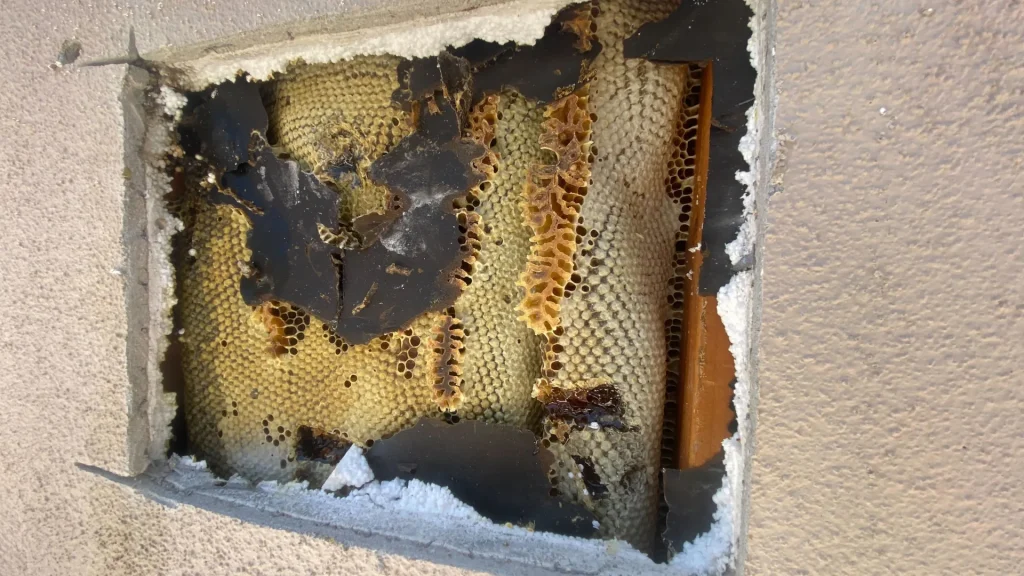
Professional removal, step by step (what we actually do)
Every house is different, but the workflow typically looks like this:
- Pinpoint the colony We track the flight path and use thermal imaging/borescope when needed to confirm comb location and size without exploratory demolition.
- Create the precise access point A small, strategic opening (drywall, soffit, or roof section) lets us remove all comb—brood, honey, and wax. Partial removal = repeat infestations.
- Live removal when feasible We use a gentle bee vacuum and transfer bees/comb to frames for relocation when safety conditions allow. (In some Africanized scenarios, humane euthanasia may be required for public safety. See Africanized Bee Guide.)
- Comb removal & sanitation All wax and honey come out. We clean residue so heat won’t liquefy remaining honey and lure pests.
- Odor control & bee-proofing We apply enzyme/neutralizer, then seal entry points—gaps at stucco/soffit, roof returns, utility penetrations, etc.
- Repair options We can provide a tidy temporary patch or coordinate finish repairs with your preferred contractor. Insurance sometimes contributes when there’s associated property damage—ask us for an estimate letter.
Want the big picture of what’s involved? Busy Bee’s breakdown is a solid companion read: What Really Goes Into Professional Bee Removal (And Why It’s Not a $99 Job)

How much does bee-in-wall removal cost in Phoenix?
Pricing varies with access (1st vs. 2nd story, roof vs. wall), comb size, material (stucco/tile), and repair scope. For ballparks and line items, see our How Much Does Bee Removal Cost in Phoenix? (2025 Guide).
If you’re actively shopping quotes, compare apples-to-apples using this checklist from our partners: How to Get Affordable Bee Removal in Phoenix (Without Getting Scammed)
DIY vs. professional: hard truth time
We get it—YouTube makes everything look easy. But with bees in walls, the risk profile changes:
- Aerosol sprays don’t remove comb. You’ll trade living bees for rotting honey and a new pest problem.
- Hidden wiring & utilities in walls/soffits raise safety stakes.
- Africanized genetics are established in Arizona—disturbance can escalate fast.
For context and prevention tips, these university resources are neutral, practical reads: MSU Extension’s Prevention & Treatment and Ohio State’s Honey Bees in House Walls.
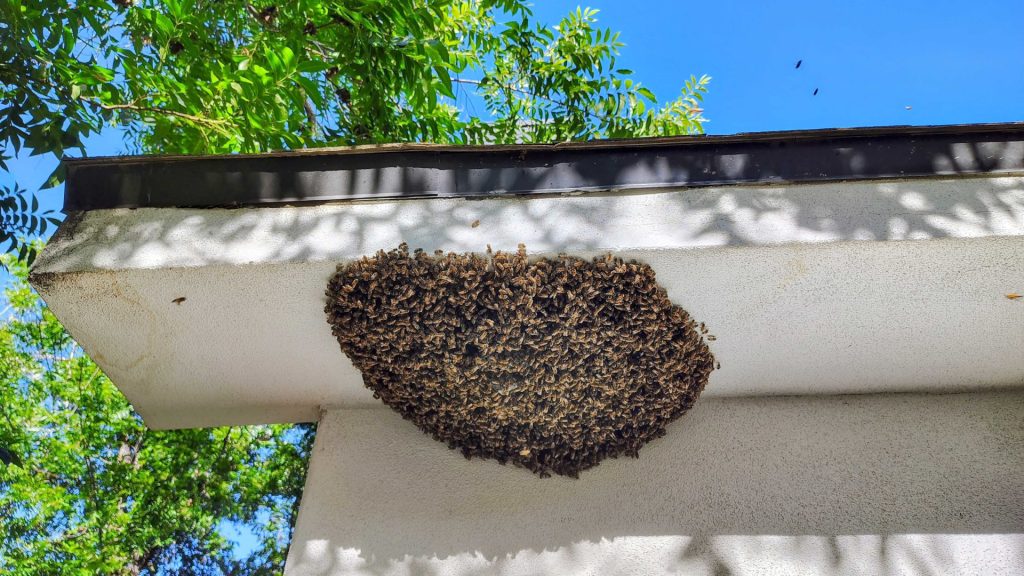
Preventing the next infestation (bee-proofing checklist)
Focus on the most common entry points in Phoenix construction:
- Seal weep screed and stucco cracks > ⅛″.
- Screen soffit/roof returns and attic vents.
- Foam/silicone around meter boxes, conduit, and hose bib penetrations.
- Trim vegetation touching eaves and walls.
- After removal, remove all honeycomb and sanitize (critical).
- Schedule a quick seasonal inspection before spring swarming.
For a broader prevention plan across the Valley, see Bee-Proofing Your Home in Phoenix: 7 Expert Tips.
Service areas (we come to you)
We handle same-day removals across the metro, including Phoenix, Scottsdale, Mesa, Chandler, Tempe, Gilbert, and more. See our full Locations page.
What to do right now (simple action plan)
- Take a 10-second video of the entry point (where you see flights).
- Don’t seal the hole—you could push bees deeper into the house.
- Note interior signs (odors, stains, warm spots).
- Call or request a quote for a quick, accurate estimate.
👉 Get a Same-Day Quote • Prefer to read more first? Bee Removal in Phoenix: What You Need to Know
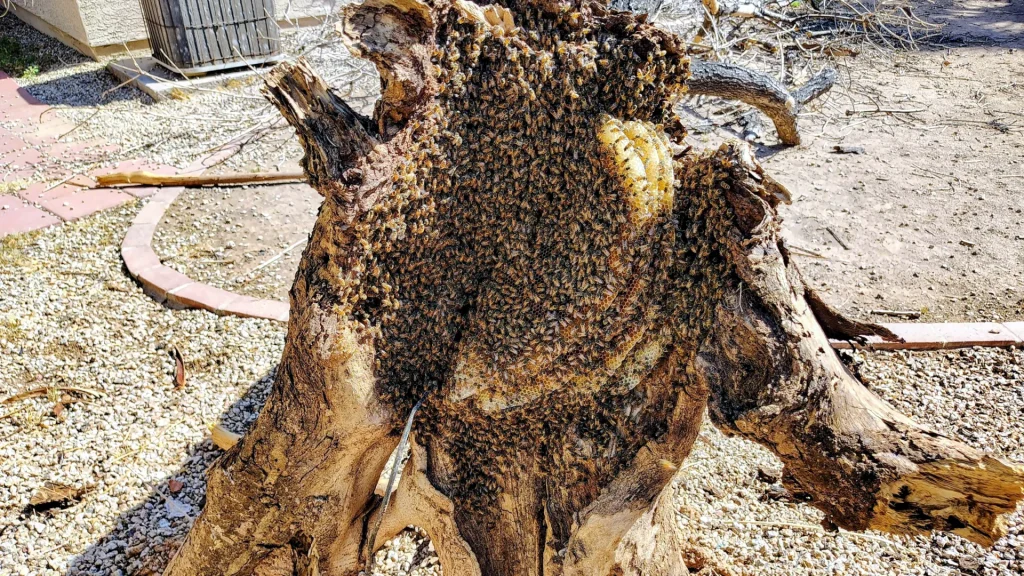
FAQs: Bees in walls (Phoenix edition)
How do I know it’s inside the wall and not just on the surface? Listen for localized buzzing that doesn’t move; watch for steady traffic to a small exterior gap. Sticky stains, warm drywall, or a faint honey smell are strong indicators. See Honey Bees in House Walls for photos and telltale signs.
Will you have to open my wall or roof? Only where the comb actually is. We use thermal/borescope first to minimize access. Removing all comb is essential to prevent melt, odor, and re-infestation.
Can you relocate the bees? When conditions allow, yes—we prioritize live removal and relocation. In higher-risk situations (aggressive/Africanized behavior), we’ll explain safety options. Read our Africanized Bee guide.
What does it cost? It depends on access, height, comb size, and repairs. Start with our 2025 Phoenix cost guide.
Will my insurance help with repairs? Sometimes, when there’s resulting property damage (honey leakage, drywall/roof issues). We can provide documentation for your carrier. LSU’s Removing Bees from Walls (PDF) covers why comb removal and sanitation are necessary.
Related resources on our site
- Bee Hive Removal Near Me in Phoenix
- Why Do Bees Swarm in Spring?
- Survive and Prevent Africanized Bee Attacks in Phoenix
Ready when you are
Whether you’re in Arcadia, Ahwatukee, or out by the White Tanks, we’ll locate the hive, remove the bees and comb cleanly, sanitize the cavity, and bee-proof so it stays solved.
Call/Text or Get Your Quote and we’ll take it from here.
